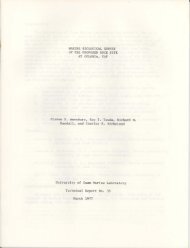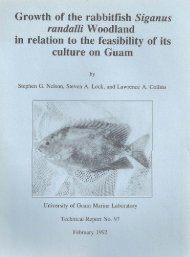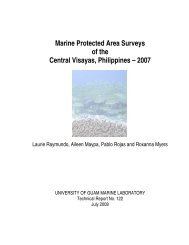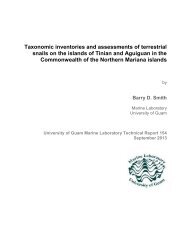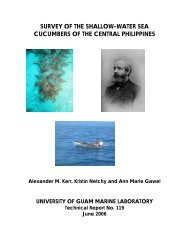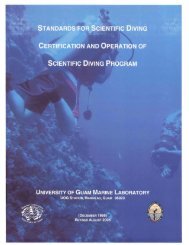Phylogeny of Holothuroidea (Echinodermata) inferred from ...
Phylogeny of Holothuroidea (Echinodermata) inferred from ...
Phylogeny of Holothuroidea (Echinodermata) inferred from ...
Create successful ePaper yourself
Turn your PDF publications into a flip-book with our unique Google optimized e-Paper software.
76 A. M. KERR and J. KIM<br />
Wills’ (1999) gap excess ratio (GER) was significantly the remaining molpadiidans, as well as their unique<br />
less (GER=0.831; P=0.0007) than those <strong>from</strong> ran- ossicle types and gross body features (filiform papillae<br />
domly permuting the range data across the phylogeny and a rectal extension in Gephyrothuriidae), currently<br />
10 5 times. The total ghost range implied by the tree make their placement problematic. As well, De-<br />
(‘minimum implied gap’) is 631.4 Mya, the minimum ndrochirotida appears to be paraphyletic and consists<br />
possible ghost range is 360.9 Mya and the maximum <strong>of</strong> a s<strong>of</strong>t-bodied grade and a testaceous clade. There<br />
is 1964.5 Mya.<br />
are, however, two reasons to view this interpretation<br />
with caution: support for the testaceous group that<br />
DISCUSSION<br />
includes the dactylochirotes is strong for only the<br />
successively weighted analysis (Fig. 3B) and is largely<br />
TAXONOMIC IMPLICATIONS<br />
defined by a single subset <strong>of</strong> characters, those as-<br />
The results <strong>of</strong> this study constitute the first cladistic sociated with a testaceous body wall.<br />
test <strong>of</strong> the classification <strong>of</strong> <strong>Holothuroidea</strong> and differ Branching order was also not confidently resolved<br />
significantly <strong>from</strong> the cladistic structure implied by within other ordinal-level clades. Within Apodida, the<br />
the current taxonomic hierarchy (Fig. 1A). Pawson & families Synaptidae and Chiridotidae have long been<br />
Fell (1965) modified ordinal designations and in- thought to be most closely related (Östergren, 1907;<br />
troduced three subclasses. The authors split <strong>of</strong>f <strong>from</strong> Frizzell & Exline, 1966) on the basis <strong>of</strong> evidence <strong>from</strong><br />
the order Dendrochirotida their new order Dac- morphology (Smirnov, 1998) and fossils (Gilliland,<br />
tylochirotida diagnosed by digitiform or digitate tentrangement,<br />
but with low bootstrap support. In Elasi-<br />
1993). Our analysis recovered the predicted aracles<br />
and a testaceous body wall. Together these two<br />
orders constitute the subclass Dendrochirotacea. The podida, the only well-supported branch was that<br />
Aspidochirotacea with shield-shaped tentacles and resolving Pelagothuriidae as sister to the remaining<br />
conspicuous bilateral symmetry include the mostly elasipodans. This result is at odds with Hansen’s (1975)<br />
littoral and tropical Aspidochirotida and the entirely conclusion that pelagothuriids are evolutionarily quite<br />
deep-sea Elasipodida. Finally, the Apodacea, hocalcareous<br />
ring, tubefeet, ventral sole and epibenthic<br />
derived because <strong>of</strong> their presumed loss <strong>of</strong> ossicles,<br />
lothuroids without tubefeet, comprises the Apodida<br />
and Molpadiida, two groups that Pawson & Fell (1965) habit. Indeed, lack <strong>of</strong> the last three characters is<br />
acknowledge may be only distantly related.<br />
plesiomorphic in holothuroids and accounts for the<br />
Our analyses did not corroborate the monophyly <strong>of</strong> parsimony algorithm’s placement <strong>of</strong> Pelagothuriidae<br />
the subclasses proposed by these authors. Dendro- below the other elasipodans.<br />
chirotacea is composed in part <strong>of</strong> the probably paranot<br />
The analyses also indicate strong support for groups<br />
phyletic group Dendrochirotida. Aspidochirotacea,<br />
delimited in recent taxonomic classifications <strong>of</strong><br />
with clades Aspidochirotida and Elasipodida, is parunique<br />
<strong>Holothuroidea</strong>. Apodida, because <strong>of</strong> its numerous<br />
aphyletic. This confirms Hansen’s (1975) suspicion,<br />
characters, has long been suspected as being<br />
which he based on the stark dissimilarities in ossicle evolutionarily quite distant <strong>from</strong> other holothuroids.<br />
form between the two groups. The Apodacea consists Semper (1868) first suggested that apodan forms pre-<br />
<strong>of</strong> two cladistically disparate orders, Molpadiida and ceded those with tubefeet. Semon (1888), after studying<br />
Apodida. These groups had been united primarily via their larval development, concluded that the Synaptida<br />
the absence <strong>of</strong> a feature, tubefeet in the extraxial body, (=Apodida) were not derived <strong>from</strong> holothuroids with<br />
an apparently primitive feature <strong>of</strong> Apodida and a tubefeet and that the “simplicity <strong>of</strong> their organisation<br />
derived one in Molpadiida.<br />
is original”. Cuénot (1891) went even further, claiming<br />
In contrast to the lack <strong>of</strong> support for the monophyly that apodans were a group <strong>of</strong> echinoderms quite dis<strong>of</strong><br />
subclasses, there was strong support for four <strong>of</strong> tinct <strong>from</strong> true holothurians. Ludwig (1891) disagreed<br />
the six taxonomic orders as clades, Dactylochirotida, with both views, reckoning <strong>from</strong> his own larval studies<br />
Aspidochirotida, Elasipodida and Apodida (Fig. 3). The that tubefeet had been lost secondarily. Nevertheless,<br />
monophyly <strong>of</strong> Molpadiida, in contrast, remains unractinopoda<br />
he elevated the apodans to ordinal status as Pa-<br />
certain. This order includes Eupyrgidae and Gethe<br />
and placed the remaining holothuroids in<br />
phyrothuriidae, two apparently derived families<br />
order Actinopoda. In this study, Semper and Sephyrothuriidae,<br />
excluded <strong>from</strong> our analyses because <strong>of</strong> their adverse mon’s phylogenetic interpretation as well as Ludwig’s<br />
effect on recovering a strongly supported phylogeny. taxonomic designations when viewed cladistically were<br />
Gephyrothuriidae has been allied over the years with strongly supported. The apodan families, Synaptidae,<br />
either the aspidochirotes or the molpadiidans Chiridotidae and Myriotrochidae, form a sister clade<br />
(O’Loughlin, 1998). Eupyrgidae has been more <strong>of</strong>ten to the holothuroids lacking tubefeet or papillae with<br />
placed, although with qualification, among the molsynapomorphies.<br />
high bootstrap proportions and seven unambiguous<br />
padiidans (e.g. Clark, 1907; Heding, 1935). In this<br />
study, these families’ consistent placements away <strong>from</strong> Finally, our analyses also uncovered a relationship





